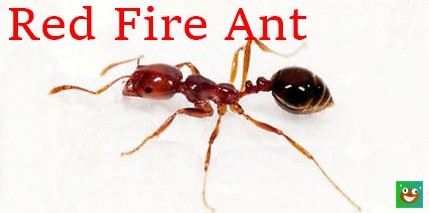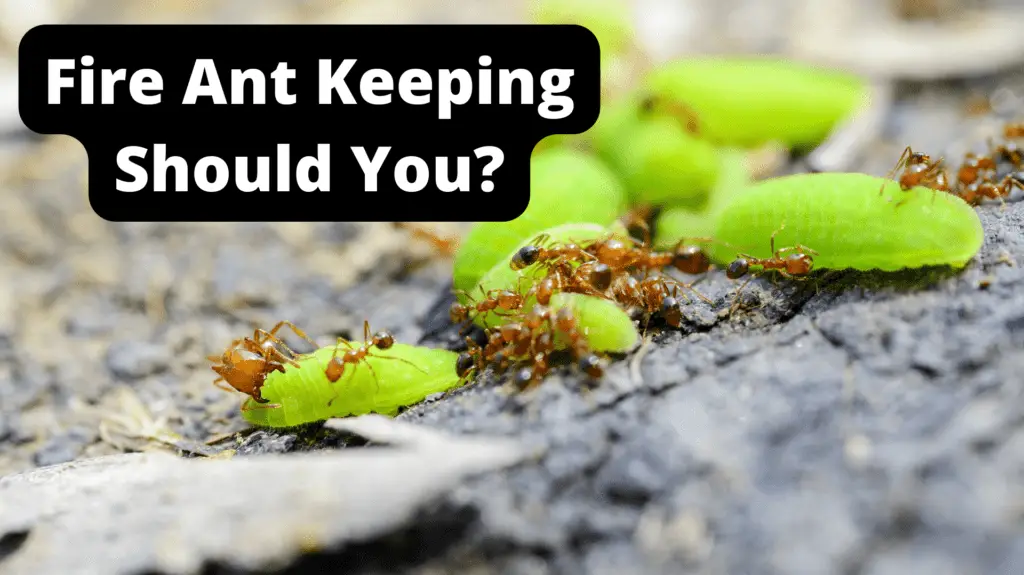The Fire Ant is one of the most widespread and invasive ants on the planet. They are highly aggressive and are known for growing massive colonies and taking over new territory exceptionally quickly. These ants also have a very powerful sting which is potentially life-threatening if your body is allergic. We’re asked many questions about Fire Ants and want to clarify some things.
A Fire Ant Farm should only be kept on an ant farm by expert-level keepers. Beginners should not keep a Fire Ant farm because these ants are highly aggressive, breed incredibly fast, chew through their ant enclosures, are extremely territorial, and are escape artist.

Problems with Keeping Fire Ants
There are a couple of problems with keeping Fire Ants on your ant farm:
- Growth Rate
- Ability to Migrate
- Eating Habits
- Aggression
Growth Rate of Fire Ants
When we say these ants grow fast, we mean it.
The eggs laid by queen Fire ants develop as grub-like larvae.
Following four growth stages, larvae transform into pupae that mimic mature Fire Ants, appearing pale and not wholly active.
When the pupae mature, their color darkens, and they molt once more to become adults.
The majority of the larvae grow into petite, flightless female workers.
These workers look after the Queen’s offspring and forage for food.
Sometimes larvae grow into bigger flying males or fertile female adults, while others evolve into smaller winged females.
This usually will happen from spring till fall when appropriate circumstances arise.
These ants can be full-grown worker ants in 15 days (Source)
While most colonies will take 1-3 years to become decent-sized, Fire Ant colonies will reach that same size in about 40% of the time.
Most people want their colonies to grow, and the work for the colony usually increases a little each month.
However, since Fire Ant colonies have such explosive growth, you can expect to go from a bit of maintenance to a ton of maintenance very quickly.
Others who have started a farm with imported Fire Ants talk extensively about how tough Fire Ant control.
These social insects are tough to handle.
For reference, you wouldn’t see that level of maintenance in another colony in upwards of a year.
Fire Ants Ability to Migrate
Their ability to migrate to different locations, become accustomed, and grow very fast has made these ants successful.
This is an awesome trait in nature, and some of these traits are also attractive to those trying to start a Fire Ant colony.
But these ants take it to the next level.
Since these ants are known for being nomadic, basically forgetting about their previous location, they’ve become professionals at moving their colony to a new location very quickly.
Typically, if another species of ant were to get loose in the house, you would be able to handle it and take care of it before they were able to move the Queen.
With Fire Ants, you’ll be racing against the clock.
Fire Ants can move the Queen ant to a new location and fully migrate the nest in about an hour.
Imagine you go out for dinner, the Fire Ants find a way to escape the formicarium, and are fully migrated into a wall or the ceiling in your house by the time you get home.
What is worse is that Fire Ants are always looking for a new home.
Due to their nomadic nature and insane growth, they are always trying to find cracks or gaps in their formicarium to make their escape.
Fire Ants Eating Habits
These ants eat anything and everything in their way.
Seeds, insects, worms.
You name it; they will eat it.
These ants decimate local ecosystems and wilderness areas by eating anything and everything in it.
The last thing you want if you grow crops is for these ants to find their way onto your agricultural land.
Whatever you want to feed these ants – they will eat it.
Many people have had success with different types of worms and cockroaches.
However, as they grow more.. they eat more.
You will go from feeding these ants every so often to feeding them a couple of times a day due to how hungry this colony will be.
Fire Ants Aggression
Fire Ants are very aggressive.
They are highly defensive and protective, which means they will protect the nest and the Queen with their lives.
But, their aggression is unique in that they will aggressively try to destroy whatever habitat you put them in.
Fire Ants will need special ant enclosures if you do decide to keep them.
This is because they are well-known for chewing through most living arrangements.
Not only are they constantly trying to escape through holes, but they’re also actively creating them by biting and ripping apart the enclosure.
Take extra precautions as they will ruin your favorite formicarium if it is not “Fire Ant proof.”
[amazon box=”B000LNR04K”]
If You Do Decide To Keep Fire Ants
Space and enclosure material is perhaps the most crucial aspects for keeping Fire Ants, aside from the obvious food and water.
While ants can go without nutrition for some time, they cannot go without moisture for very long.
Both a wet cotton ball and a surface tube can be used.
If you’re using a tube, ensure the edges are sealed with cotton swabs to allow gradual water distribution and avoid ant drownings.
Again, we do not recommend these ants for novice ant keepers as there are various ant types to pick from, and finding one that suits you is usually pretty easy.
Honestly, Fire Ants should probably be kept off your ant farm, and out of your house.
That doesn’t mean don’t do it; just don’t let any get out.
If they get away, they could become quite a problem very quickly.
While we do not suggest Fire Ants for new keepers, we do have a guide that is more beginner-oriented here: How to Get Started with Ant Keeping




